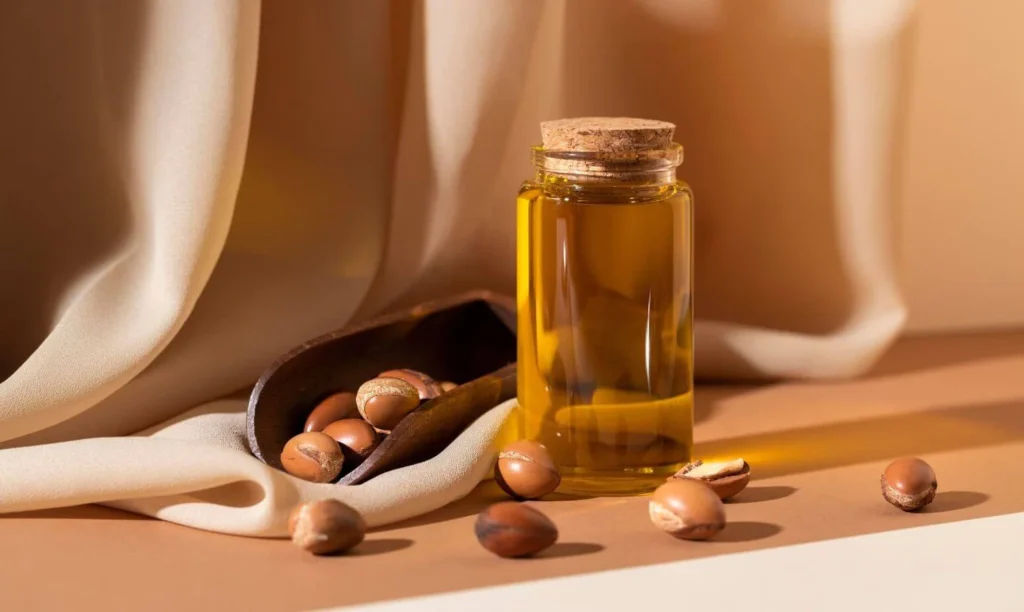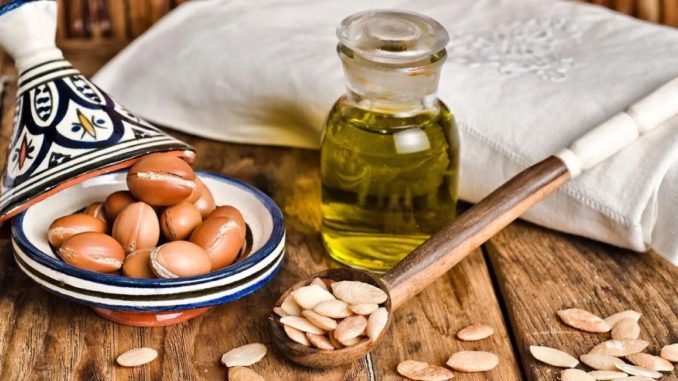Introduction
Morocco is a country steeped in rich cultural heritage and traditions that date back centuries. One aspect of Moroccan culture that has withstood the test of time is their use of argan oil. Indigenous to the regions of Morocco, argan oil has long been revered for its medicinal and culinary properties.Derived from the kernels of the argan tree’s fruit, argan oil extraction is an intricate women-led process that has been passed down through generations. Beyond nourishing skin and hair, argan oil serves as an economic lifeline for many rural Moroccan families.
In recent years, argan oil has gained widespread popularity outside of Morocco as demand surges globally. However, its origins remain rooted in Moroccan cultural traditions, where various healing remedies using argan oil have endured for centuries. This article explores argan oil’s storied history and diverse applications in Moroccan folk medicine traditions. I examine how argan oil became an essential part of Moroccan culture while promoting women’s empowerment. The article also acknowledges modern research validating many of argan oil’s traditional medicinal uses. Overall, I aim to shine a light on how argan oil revives Morocco’s rich cultural heritage while boosting the country’s economy and empowering women in rural regions.
Argan Oil’s Ancient Origins in Moroccan Folklore
The earliest references to argan oil originate from Moroccan folklore and ancient folk medicine practices passed down orally for generations. Indigenous Berber communities residing in the historic argan forest regions have long held beliefs about argan oil’s healing and restorative properties. According to folklore, argan oil was a gift bestowed upon the Berber people from their ancestral spirits to use for nourishment and remedy. Historical records from the 13th century make some of the earliest documentations of argan oil extraction processes and uses in Morocco.
Rural Berber women traditionally performed the intricate task of harvesting argan fruits, cracking the nuts, and extracting oil through stone grinding. This female-dominated practice became ingrained in Berber culture as women shared knowledge across generations. Argan oil was a prized commodity, held with such regard that it was sometimes used as a unit of currency in remote villages. Both culinary and medicinal uses evolved over centuries based on oral traditions and experimentation. Conditions like skin irritations, joint pain, and digestive issues were commonly self-treated at home using cold-pressed argan oil.
As Morocco’s main export in the 17th-19th centuries, argan oil gained recognition for beauty and nutritional benefits. Merchants transported it along caravan routes, establishing Morocco as a key supplier throughout Africa, the Middle East, and Europe. Early European traders sailing along Morocco’s coast were among the first foreigners to discover argan oil and import it abroad. Records from this period describe argan oil’s rarity and high value internationally due to labor-intensive production centered exclusively in Morocco.
This history reflects how argan oil was ingrained as a cultural icon in Morocco through oral teachings surrounding both practical uses and ancient spiritual beliefs. Rural Berber communities preserved argan oil’s artisanal extraction methods entirely by hand for over eight centuries. Their inherited customs demonstrate how folk knowledge of argan oil’s nourishing properties evolved organically over many generations. This folkloric foundation underscores argan oil’s enduring significance in Moroccan heritage and medicine traditions.
Moroccan Women Uphold the Craft of Argan Oil Production
Argan oil production centered around rural Berber women has empowered them economically and sustained their communities for centuries. Extracting oil is a meticulous year-long process requiring significant labor. The first step involves gathering ripe argan fruits that have fallen to the ground from argan trees growing in semi-arid regions of Morocco. Women then collect the fruits and leave them to dry under the sun for several weeks.
Once fully desiccated, the argan fruits are typically cracked open by placing several together and hitting them forcefully with stones. This liberates the seeds, which are then roasted to make the kernel extraction easier. Using various traditional tools like smoothing stones, women carefully peel away the kernels to gather the nutmeats inside. At this point, the nutmeats are ground into a paste using successive grinding stones. Finally, the paste is kneaded and pressed to extract the precious argan oil through its richness and color.
Every stage demands tremendous physical stamina and attention to detail over many hours each day. On average, it takes a full day’s work to produce just 30 milliliters of oil from the laborious process. Despite immense hardship, argan oil production was deeply empowering as Berber women controlled a highly valuable agricultural product. Their income supported entire families and villages, especially in regions lacking other economic opportunities for women.
Preserving argan oil craftsmanship has remained a female-led endeavor as skills are transferred between generations of Berber women. Younger rural women continue learning argan oil techniques through observation and practical guidance. This oral teaching method ensures harvest techniques stay aligned with cultural and environmental sensitivities. Additionally, it promotes the sustainability of argan trees as harvest areas are carefully monitored. Traditional cooperatives now assist women by providing necessary tools, stable markets, fair trade prices and organizational support.
Through their persistent efforts over centuries, Berber women have secured argan oil’s prominence in Moroccan culture and global markets. Their indispensable role reviving this industry safeguards not only livelihoods but also endangered argan forest habitats. International recognition for Moroccan argan oil has brought deserved attention to the strength and perseverance of Berber women artisans. Their resilient craftsmanship conserving ecological and cultural traditions exemplifies how local knowledge systems can sustain people and planet harmoniously.
Multifaceted Medicinal Uses Supported in Moroccan Traditions
In Moroccan folk traditions, argan oil gained renown and popularity due to its diverse effective uses for common ailments. Alongside staple culinary functions, applying or ingesting argan oil became trusted home remedies passed through generations. Over time, certain conditions tended to associate preferentially with argan oil based on anecdotal experiences shared locally. While evidence was historically anecdotal, modern scientific analyses have begun validating numerous traditional argan oil folk uses. Here are some of the major ethno-medical applications argan oil faced in Moroccan households:-

Skin and Hair Care
Topical argan oil application featured prominently in Moroccan beauty rituals due to its restorative properties. Massaging a small amount onto dry skin helped remedy conditions like eczema and psoriasis. It also calmed bacterial, fungal and viral rashes. For hair, argan oil moisturized strands and scalp while reducing dandruff, splits ends and frizz. Its nourishing emollient composition strengthened hair and aided growth. These usages align with argan oil’s richness in fatty acids, sterols, tocopherols and phenolic compounds favoring skin homeostasis.
Muscle Relief
Rubbing argan oil gently into sore, aching muscles offered relief from stress and tension. Traditionally it targeted muscle spasms, back pain and arthritis when massaged topically. The high oleic acid content gives argan oil mild analgesic, anti-inflammatory qualities helping soothe strained muscles and joints. This local application method aligned well with treating chronic muscle issues commonly faced, especially by the aging population.
Digestive Health
In Morocco, small doses of argan oil taken orally aimed to improve digestion by easing symptoms like gas, bloating, diarrhea and constipation. Caring for digestive complaints frequently faced in rural areas without modern conveniences or nutrition security. Research supports argan oil’s ability to lubricate the GI tract, soothe inflammation and positively influence the gut microbiome, thus its endorsement in Moroccan traditions for common digestive issues.
Cardiovascular Benefits
Early observations linked argan oil’s nutritiousproperties to cardiovascular advantages. Specifically it was thought to keep blood pressure levels stable and control cholesterol balance. Its healthy fatty acid profile reduces “bad” LDL cholesterol while raising “good” HDL levels, protecting against blockages and harmful plaque. These potential contributions to heart health were considered valuable preventive measures in communities strained by limited medical infrastructure and hazardous labor.
Anti-Aging Effects
Applying argan oil to the skin or consuming it orally may slow naturally occurring wrinkles and age spots according to Moroccan folk wisdom. This belief originates from argan oil’s exceptionally high vitamin E content as a powerful natural antioxidant. Regular use was suggested to minimize visible signs of skin aging by combating oxidative damage from sunlight, pollution etc. The nourishing nutrients enriched collagen levels while maintaining skin elasticity and moisture over the long run.
While practical knowledge built up over generations, these versatile ethno-medical applications derived directly from observing argan oil’s impacts on community health through ancestral non-invasive practices. Their traditional endorsements have increasingly gained scientific confirmation in recent decades through bio-chemical analysis and clinical studies. This convergence demonstrates how indigenous medical systems can offer valuable naturally sourced solutions meriting further exploration. It also affirms the innovative potential lying untapped in other traditional medicinal practices worldwide.
FAQs
Comments
0 comments

